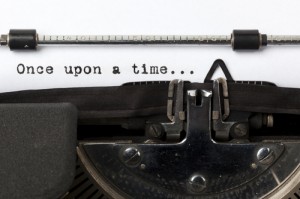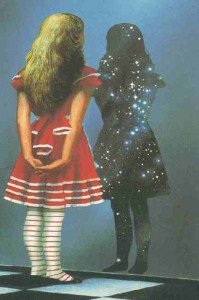Once upon a time, there was a beautiful princess who lived in a dark castle guarded by a fire-breathing dragon, always dreaming of the day a young man would come and rescue her from the evil sorcerer who had kidnapped her and trapped her there. One day, a brave knight stormed the castle on his trusty steed, slew the dragon and killed the sorcerer. He rescued the princess from her lonely tower and took her back home to her kingdom. The king and queen were so grateful to the knight that they offered him their daughter’s hand in marriage, to which he and the princess gladly agreed. The knight and the princess were married, and they lived happily ever after. The End.
This is a classic fairy tale formula: villain has damsel, hero goes after damsel, hero defeats villain, hero and damsel fall in love and live happily ever after. The exact course of events may vary from story to story, but the basic idea is usually the same. Also universal in romantic fairy tales, if you’ll notice, are the character archetypes present in the plot. So pervasive are they in fiction that we’ve been trained from childhood to recognize them on sight: the handsome prince or the knight in shining armor; the beautiful princess or the young lady in need of rescue; the evil villain who stands in the way of true love, etc. And while these characters clearly serve their purpose when it comes to telling a well-rounded story, we as writers must ask ourselves why they don’t (or at least shouldn’t) appeal to us as satisfactory vehicles for the tales we wish to tell.
 The main problem with the fairy tale characters is that they’re “plug-in” types. They’re like mass-produced instant ramen noodles: conveniently cheap and easy to prepare, but not exactly a healthy choice. When basic character profiles are used excessively over the years, they inevitably become clichéd and uninteresting. And intelligent readers don’t want clichéd and uninteresting; they want to see through the action on the pages to glimpse another level of the characters. They want depth.
The main problem with the fairy tale characters is that they’re “plug-in” types. They’re like mass-produced instant ramen noodles: conveniently cheap and easy to prepare, but not exactly a healthy choice. When basic character profiles are used excessively over the years, they inevitably become clichéd and uninteresting. And intelligent readers don’t want clichéd and uninteresting; they want to see through the action on the pages to glimpse another level of the characters. They want depth.
As writers, we are obligated to act as intelligent readers of our own works, even super-intelligent. We need to have a complete understanding of our characters that transcends our readers’ perceptions. To achieve this, we have to provide our characters with personal details that make up a life outside of the main action in the story, a life that will save them from being labeled as “ordinary” and keep our readers intrigued. So how exactly do we manage this?
Amelia stared out of the window of her room for what the scratched-up wall behind her claimed was the thirty-second day in a row. Yet again, she found herself longing to visit the rolling hills in the distance. It was so boring in her room: all the walls had already been painted twice in a dozen different colors, and she was out of embroidery supplies for the third time that week. She wanted to go outside, where there was fresh air and animals to chase and adventures to be had every day. She wanted her freedom back.
Good fictional characters are like real people: unique. They have backstory, flaws, fears and dreams. The best ones also have personal goals that often serve the important purpose of driving their stories forward. Can you think of anyone else who might fit that description?
Petrus, the lonely philosopher that she liked to visit on occasion, had foolishly thought it would be a good idea to get a small pet dragon to keep him company in his otherwise abandoned castle at the far edge of the forest. The second Amelia had stepped through the gate, the darn beast had chased her across the courtyard straight into the building, where her friend had told her that until he could find a way to subdue the dragon, she would have to stay inside where it was safe. That was a month ago.
Something I’ve noticed that I tend to do a lot when writing fiction is insert elements of my own personality and ideals into my stories. Although its usually done subconsciously, I feel this has helped me tremendously when trying to create believable characters. It isn’t just me, of course; many of the stories I’ve read seem to reflect characteristics of the writer behind them, as much the favorable as the less-than-flattering. Speaking from my experience, not only is this a practice that’s probably very common among knowledgeable writers, but that should really be encouraged among beginners, especially those who are prone to following the flat “Once upon a time” formula.
Jack couldn’t remember how he had ended up here. One minute, he was standing atop a tree beside a stone wall, trying to figure out where he was after being lost for an hour; the next, he was waking up in the courtyard on the other side of the wall next to an unconscious dragon and a huge broken branch. Before he knew it, an old man in a dark robe and a young girl his own age had run out of the nearby castle and were thanking him for his heroic deed. What heroic deed? Jack insisted he was no hero; he was just a squire who’d gotten lost after being separated from the knight with whom he was traveling to the kingdom. Nonetheless, the philosopher was grateful for this stroke of good luck, and requested that Jack accompany Amelia back home. She knew the way, he assured the boy, and her father was sure to reward him handsomely for his deed. The man was, after all, an advisor to the king himself…
Writing yourself into your stories has a few major advantages:
- It makes it easier to write in a way that readers will find relatable;
- It helps you develop a better familiarity with the characters you’re creating (after all, who knows you better than you, right?); and
- It allows your readers a subtle means of getting to know the writer behind the words.

Alice Through the Looking Glass, by Lewis Carroll
(Image via Scientific American)
The story shared here is just a silly fairy tale twist that I improvised, but which still serves to demonstrate how I tend to base elements of my writing on myself. Amelia’s painted walls and embroideries reflect an artistic side, though the adventurous dreamer in her is also a comment on my idealistic views about women who are independent thinkers. Petrus, being a philosopher, is a type of character who’s expected to be intelligent, but who still isn’t immune to bad decisions brought on by negative emotions like loneliness (why else would anyone get a pet dragon if they had no clue how to handle it?). Even Jack is a quirky character of humble status who would hardly consider himself a hero had he not been in the right place at the right time.
The traits I’ve taken from myself give all these characters a certain depth that separates them from their two-dimensional parallels in the first story and (hopefully) makes the second story a more interesting read. In this way, by writing yourself into your own stories, you can add color to your characters’ profiles and create tales that not only appeal to your intelligent readers, but also give them a chance to catch glimpses of the unique person that is you.
Amelia bid Petrus farewell as he fettered the unconscious dragon, thanking him for taking such good care of her for the past month. She then led the way to the nearby kingdom that was her home, and after reuniting with her worried parents, she introduced Jack as her new friend. The boy was awarded knighthood for taking down a dragon and saving the advisor’s daughter, and he and the girl quickly became best friends. For several years, Jack and Amelia continued to visit Petrus together and pursued many adventures throughout their adolescence, until at last they reached adulthood and realized they had fallen in love. The two friends were eventually married, knowing they’d be very happy together for the rest of their lives. Their greatest adventure had only just begun.
What about you fellow fiction writers? How do you draw inspiration for creating your characters? Do you recognize traces of yourself in any of your stories?


Another way to bring relatable traits to your characters is to watch the world around you. I glean bits and pieces just by watching my family interact. You’d be surprised at the gems you can find=)
True, that’s a great way to find inspiration for characters! I find a lot of interesting traits in my friends and family too; in fact, I even plan to write a blog post about that sometime in the future. 🙂
Umm, I have even titled one or two working drafts with my own name, just to remind me what voice to write in for the main character! After all, why not daydream a different life on the page? But generally, I do take aspects of the people I know for my characters. In fact, I find it easier to bring in aspects of people I either dislike or don’t understand – these people and their character traits seem more interesting to me, and through writing, I find I gain more of an insight into their possible motives in the real world – interesting..
Haha, yes, writing based on others can be a lot of fun, especially when you’re trying to get into a different mindset than your own. Injecting yourself into your stories is just one of various approaches to creating relatable prose. I tend to find this practice easier probably because my extreme shyness has kept me from interacting with a lot of people in my lifetime. In fact, it’s become so second nature for me that even when I try to write based on other people, I usually read the story back to find a little piece of myself anyway! 😛